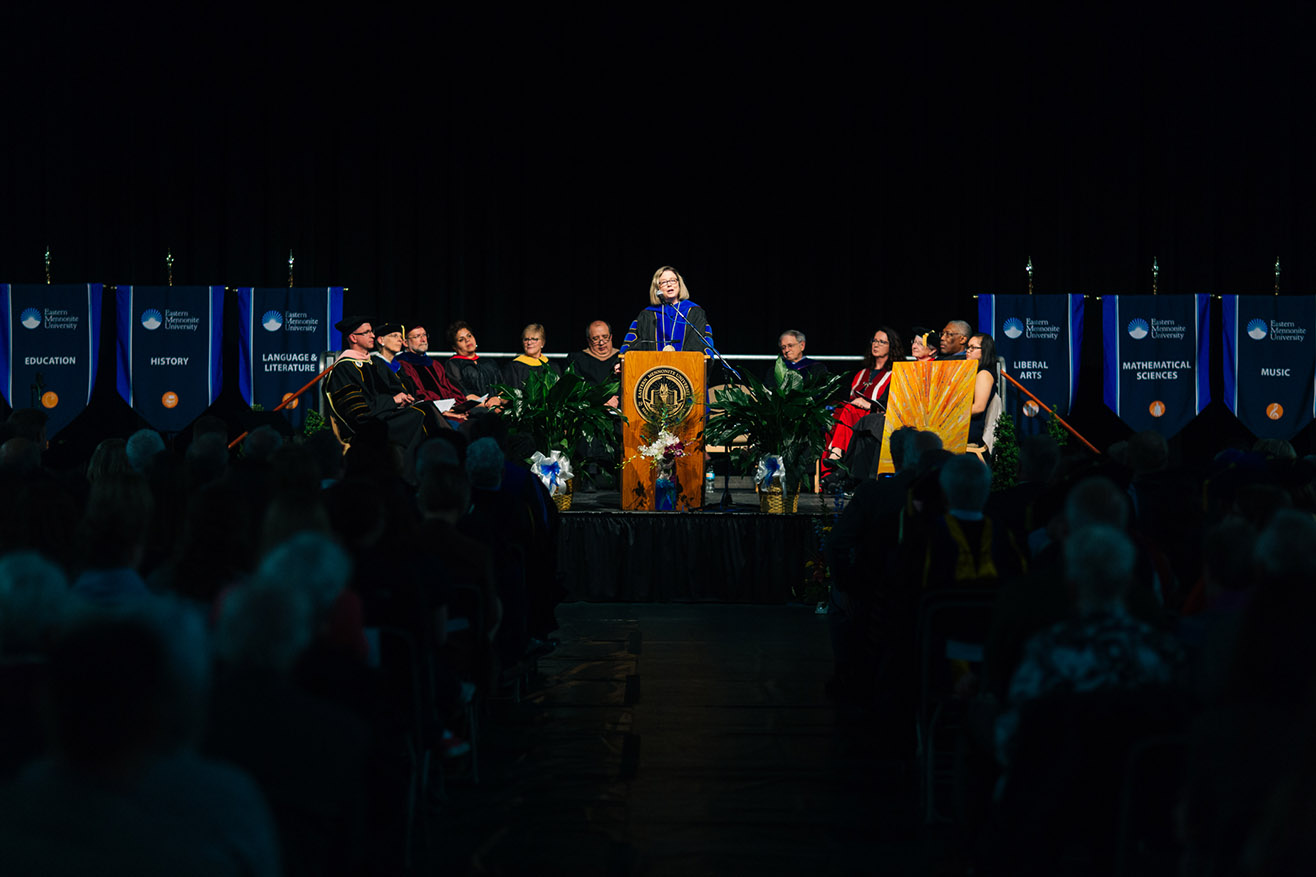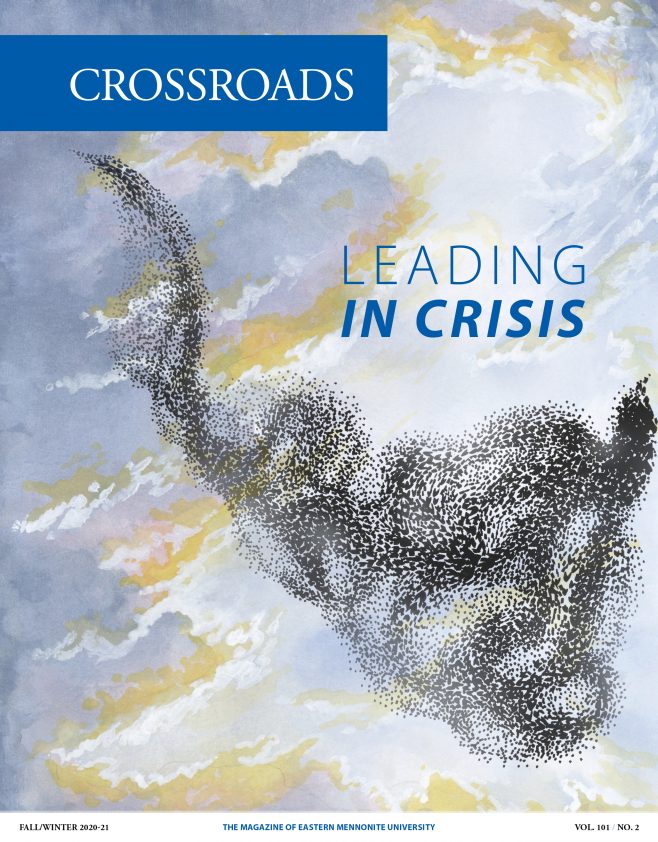
Surrounded by dignitaries, Dr. Susan Schultz Huxman speaks during the inaugural ceremony at Eastern Mennonite University. She is the university’s ninth president. (Photo by Andrew Strack)
An address by Dr. Susan Schultz Huxman on the occasion of her inauguration, April 7, 2017
Today, I want to speak about an important word and an important story that I think captures our calling as academic leaders deeply invested in equipping our students for meaningful work and service in our world today.
One year, I was teaching middle school Sunday school in Wichita, Kansas. (Yes, I drew the short straw among parents with “spirited” middle school children at that time.) Teaching children age 11-13 is not for the faint-hearted. For me, as a university professor, it was a good weekly dose of humility!
One Sunday morning, we examined this question: Which words in the Bible are the most fascinating or mysterious to you? You should know that I’m a rhetoric scholar, so of course this question was especially important to me. And like a good researcher collecting field notes, I thought what would the “tribe” of 11-13 year olds tell me?
All sorts of words were submitted amidst tussles and pillow fights and snacks: In the end, the kids selected the word Behold and the even more archaic Lo and behold. We soon discovered that behold is mentioned 1,326 times in the King James Version (somebody had an app for that). Interestingly, the word is used far less in contemporary versions. Some of our favorite passages were: Behold, the Lamb of God and Behold, I stand at the door and knock. And especially: Behold, I bring you good tidings of great joy.
On one level, the word behold means “to see, to face, to apprehend, to consider intensely, to observe fully.” It is a call to keep our eyes open wide to make sure we are seeing and hearing clearly and accurately. On a deeper level, the expression lo and behold often is accompanied with an exclamation mark. It means Stop! Suspend time! An Awesome Mystery, or something unusual and unconventional, is unfolding before you – and you will miss it if you are not perfectly still and attentive! As the psalmist reminds us: “Be still and know that I am God!”
Our fascination with the word behold is partly because it feels so out of place in our overwhelmingly fast-paced, hurdle-head-first-into-the-future-while-we-juggle-multiple-digital-devices daily routines. A contemporary substitute for the word behold is be mindful…
A behold moment came in the Commonwealth of Virginia in the fall of 1917. After nearly a decade of debate over location, leadership, mission, name, cost and curriculum, the Mennonite Church took a deep breath and a giant leap of faith and opened Eastern Mennonite School.
Students were literally waiting on the road for the first president – J.B. Smith, originally from St. Jacobs, Ontario – to get off the train and open the doors to the school! Four faculty, including the president, were hired to teach three subjects: Bible, literature and agriculture. Vocal music was allowed, but NOT instrumental music. Sports were allowed (for boys), but no varsity competition. And a plain dress code for men and especially for women was codified long before lesson plans or food choices.
Lo and behold! Here we are 100 years later. And just let me say – how amazing is this – that I have this blessed opportunity to serve this crown jewel of a school just as it is launching its centennial celebration!
Today, in 2017, we have nearly 2,000 students, two additional instructional sites, well over 100 faculty, more than 60 programs of study, and 17 varsity sports teams open to men and women. We have team colors, yes, but no dress code. And we offer all kinds of music, including the originally forbidden kind: instrumental music.
As importantly, EMU went from a handful of nearly all white Mennonite kids from rural communities in 1917 to significant diversity of color, ethnicity, nationality, geography, identity and faith backgrounds in 2017.
Yes, we’ve been on quite an amazing growth trajectory these past 100 years. And we’ve had beautiful and brazen behold moments at EMU ever since! –way too many to enumerate here today, save one…
One such precious stop-and-marvel moment includes this gem: The first African-American student admitted to college in the state of Virginia was right here at Eastern Mennonite. The year was 1948. Segregation was the law of the land. This was a decade before the Civil Rights Movement. The first African- American student graduated from EMU in 1954, the same year Brown v. Board of Education was decided. Virginia public schools would not integrate for four more years…
Indeed, careful attention to diversity continues to be a goal at EMU. It is critical to the fulfillment of our mission. It is one of the reasons that I am here. We still have our work cut out for us on the diversity front, no question, but we’re moving in the right direction!
The EMU story in all of its expanding chapters is cast upon a much larger canvas – the Christian story – steeped in unconventional “behold” moments that cascade one after the other from beginning to end.
Is it any wonder that the biblical story interjects so many angelic messengers to bring behold announcements to God’s unsuspecting people? Who would believe it otherwise? God uses Esther, a Jewish woman, to risk her life to save God’s people? Really? An unwed teenager will birth the Son of God? Really? Jesus will call his disciples from the blue collarclass- fisherman? Really? Jesus will consort with misfits, outcasts, and unbelievers? Really? The last shall be first? Really? The first “witnesses” of the resurrection are all women – scandalous.
Jesus was all about unconventionality. He was human and divine, lion and lamb. The axis of the cross reminds us we need contemplative prayer and bold practice; we need to be redeemed and repair the world! And yet our default mindset, in the West, is to forever bifurcate, divide and analyze in either/or, for or against, problem-solution thinking.
Mennonite schools were founded on the impulse to capture the unconventional both/and ethos of a Christ-centered story. We aim to educate mind, body and spirit. To very intentionally nourish head, hands and heart.
How this kind of educational ethos plays out on our campuses is often referred to as the “invisible curriculum.” It begins with a sacred premise: all students are viewed as gifted people created and loved by God. This is followed by careful attention to layers upon layers of community building – layers as thin yet as durable as paper mache to the formation of artistic creations.
How valuable is such an aspiration? One of my favorite literary and journalistic writers, Anna Quinlin, says this: “It’s so much easier today to craft a résumé than to craft a soul.”
Put simply: The invisible curriculum helps students craft souls. This unconventional curriculum includes a large supporting cast of “salt of the earth” people: professors, librarians, coaches, cooks, custodians, carpenters, counselors, chaplains and a whole assortment of other critical staff, all employees at our schools – who are full of joy and curiosity and who view their interactions with students as spirit-filled encounters that happen every day inside and outside the classroom.
When you pair the rigorous academic and visible curriculum at EMU with the communal formation of the invisible curriculum, what do you get? Quality education! And, it gives our students life-changing, eyes-wide-open, stop! apprehend! and breathe deeply experiences. And those life-changing experiences really become counter-cultural stories to be treasured, told and retold for a lifetime.
You heard my father share the African saying, “If you inherit land, you have to farm it. If you inherit a story, you have to tell it.”
I have inherited a powerful “Behold!” story that is now my duty to tell. As Eastern Mennonite University’s ninth president and first woman president, at the dawn of our second century, I welcome the opportunity to shine the light of our distinctive mission, elevate our bold vision to be a Christian university like no other, and build innovative partnerships that are steeped in great faithfulness, countercultural practice and reverent “lo and behold” attentiveness.
I love to tell our unfolding, unconventional story in harmony with the “old, old story of Jesus and His love.” May it be our glorious theme today and always!
This address has been edited for length.
